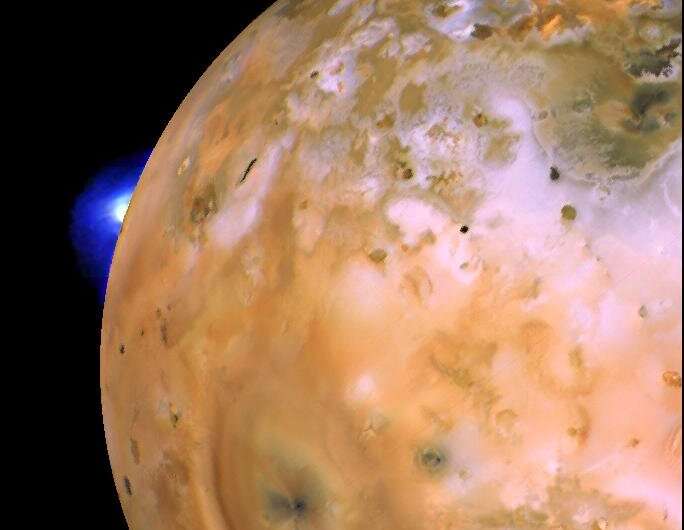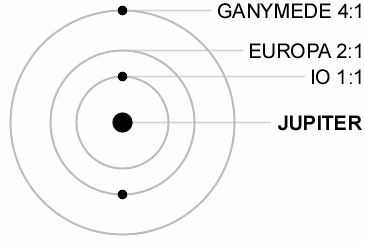New study traces Io's volcanic tides

Hundreds of volcanoes pockmark the surface of Io, the third largest of Jupiter's 78 known moons, and the only body in our solar system other than Earth where widespread volcanism can be observed. The source of the moon's inner heat is radically different than Earth's, making the moon a unique system to investigate volcanism.
A new study in the AGU journal Geophysical Research Letters finds Io's most powerful, persistent volcano, Loki Patera, brightens on a similar timescale to slight perturbations in Io's orbit caused by Jupiter's other moons, which repeat on an approximately 500-Earth-day cycle.
The new results are surprising because volcanoes on Io do not erupt in time with larger fluctuations in the far greater stresses inflicted on Io during the moon's 1.77-Earth-day orbit around Jupiter. Internal friction from these stresses generates the heat that powers Io's volcanoes, but fluctuating stresses during the short period of Io's orbit don't appear to squeeze magma to the surface.
The new study, which analyzed 271 nights of observations of Loki Patera from Hawaii's Keck and Gemini North telescopes from 2013–2018, and more sporadic observations dating back to 1987, suggests the gentler, 500-day cycle may act on the right timescale to move magma and bring it to the surface of the moon in an eruption.
"The stresses on Io's interior vary a lot during that 1.77-day orbit," said Katherine de Kleer, a planetary scientist at the California Institute of Technology and the lead author of the new study. "As far as anyone has been able to tell, there is no variation in Io's volcanoes on this 1.77-day scale, so it's a bit counterintuitive that we would see a response over the longer period, when the changes in stress are lower."
Understanding this dynamic may provide clues to Io's mysterious interior as well as the interiors of other bodies in the solar system warmed by a fluctuating pull of gravity, an effect called tidal heating.
"We know almost nothing about what Io's magma chambers and conduits are like, so Loki Patera's behavior is giving us a small window into an area where we currently have zero information," said de Kleer.
Moon dance
Io has a hot interior because its tight orbit around Jupiter is not circular. The moon is stuck in an eccentric orbit because it resonates with Jupiter's largest moons, neighboring Europa and Ganymede, caught between their influence and the massive gravity of Jupiter.

Europa's orbit around Jupiter is twice as long as Io's, and Ganymede's orbit is twice as long as Europa's. This 1:2:4 rhythm means the pull of gravity from the other two moons repeats consistently as Io orbits around Jupiter.
Io's distance from Jupiter changes over the course of its elliptical orbit, so it experiences a different amount of Jupiter's gravity as it circles the massive planet. The shifting pull of Jupiter and the other moons stretches and compresses Io on its two-day orbit around Jupiter. This generates enough heat from friction within the materials of the moon's interior to melt rock into magma.
Researchers studying the more than 400 volcanoes on Io have looked for evidence that they erupt on the same beat. Such a fluctuation with daily orbit occurs on Saturn's moon Enceladus, which has an underground ocean that spurts out through cracks in the moon's frozen surface. Water geysers on Enceladus bloom largest when the moon is at its furthest point from Saturn and the fractures sourcing the geysers are being pulled open.
But the new study did not find evidence that Loki Patera keeps the same time as Io's two-day orbit around Jupiter. Instead, its brightness appears to fluctuate at a similar timescale to subtle perturbations in Io's orbit.
Although orbital resonance with Europa and Ganymede exerts the largest tidal effects on Io, the neighboring moons also slightly warp the shape of Io's orbit in cycles lasting 480-484 days and 461–464 days. Loki Patera appears to erupt on a cycle that is similar to this timeframe, according to the new study.
Slow flow
De Kleer and her colleagues think the different dynamics on Io and Enceladus may have to do with the way fluids move through pores or cracks in rock. Magma is more like honey or toothpaste than water. It does not respond as quickly as water to squeezing. The period of Io's orbit may be too short for tidal effects in the moon's interior to erupt onto the surface.
"The magma in Io's crust takes time to flow," said Francis Nimmo, a geophysicist at the University of California Santa Cruz and co-author on the new paper. "If you squeeze and stretch the crust rapidly, nothing happens; but if you squeeze and stretch it more slowly, the magma has time to move far enough to fill a volcanic conduit, causing an eruption. It's similar to the way you can run on wet sand, but if you walk slowly your feet sink."
What scientists learn about tidal heating effects from studying Io could be applicable to Europa and other bodies throughout the solar system that are tidally heated, according to the authors of the new study.
"On other worlds its more difficult to study this fundamental planetary process because it doesn't generate these volcanoes that are so easy to observe," de Kleer said. "Io serves as a laboratory for gaining insight into this process which can then be applied to other moons in the solar system."
More information: Katherine Kleer et al. Variability in Io's Volcanism on Timescales of Periodic Orbital Changes, Geophysical Research Letters (2019). DOI: 10.1029/2019GL082691
Journal information: Geophysical Research Letters
Provided by American Geophysical Union
This story is republished courtesy of AGU Blogs (http://blogs.agu.org), a community of Earth and space science blogs, hosted by the American Geophysical Union. Read the original story here.




















